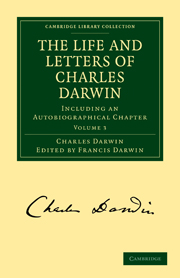Book contents
- Frontmatter
- Contents
- CHAPTER I THE SPREAD OF EVOLUTION. ‘VARIATION OF ANIMALS AND PLANTS’—1863–1866
- CHAPTER II THE PUBLICATION OF THE ‘VARIATION OF ANIMALS AND PLANTS UNDER DOMESTICATION’—JAN. 1867–JUNE 1868
- CHAPTER III WORK ON ‘MAN’—1864–1870
- CHAPTER IV THE PUBLICATION OF THE ‘DESCENT OF MAN.’ THE ‘EXPRESSION OF THE EMOTIONS’—1871–1873
- CHAPTER V MISCELLANEA, INCLUDING SECOND EDITIONS OF ‘CORAL REEFS,’ THE ‘DESCENT OF MAN,’ AND THE ‘VARIATION OF ANIMALS AND PLANTS’—1874–1875
- CHAPTER VI MISCELLANEA (continued). A REVIVAL OF GEOLOGICAL WORK—THE BOOK ON EARTHWORMS—LIFE OF ERASMUS DARWIN—MISCELLANEOUS LETTERS—1876–1882
- BOTANICAL LETTERS
- CHAPTER VII FERTILISATION OF FLOWERS—1839–1880
- CHAPTER VIII THE ‘EFFECTS OF CROSS- AND SELF-FERTILISATION IN THE VEGETABLE KINGDOM’—1866–1877
- CHAPTER IX ‘DIFFERENT FORMS OF FLOWERS ON PLANTS OF THE SAME SPECIES’—1860–1878
- CHAPTER X CLIMBING AND INSECTIVOROUS PLANTS—1863–1875
- CHAPTER XI THE ‘POWER OF MOVEMENT IN PLANTS’—1878–1881
- CHAPTER XII MISCELLANEOUS BOTANICAL LETTERS—1873–1882
- CHAPTER XIII CONCLUSION
- APPENDICES
- INDEX
CHAPTER VII - FERTILISATION OF FLOWERS—1839–1880
Published online by Cambridge University Press: 29 August 2010
- Frontmatter
- Contents
- CHAPTER I THE SPREAD OF EVOLUTION. ‘VARIATION OF ANIMALS AND PLANTS’—1863–1866
- CHAPTER II THE PUBLICATION OF THE ‘VARIATION OF ANIMALS AND PLANTS UNDER DOMESTICATION’—JAN. 1867–JUNE 1868
- CHAPTER III WORK ON ‘MAN’—1864–1870
- CHAPTER IV THE PUBLICATION OF THE ‘DESCENT OF MAN.’ THE ‘EXPRESSION OF THE EMOTIONS’—1871–1873
- CHAPTER V MISCELLANEA, INCLUDING SECOND EDITIONS OF ‘CORAL REEFS,’ THE ‘DESCENT OF MAN,’ AND THE ‘VARIATION OF ANIMALS AND PLANTS’—1874–1875
- CHAPTER VI MISCELLANEA (continued). A REVIVAL OF GEOLOGICAL WORK—THE BOOK ON EARTHWORMS—LIFE OF ERASMUS DARWIN—MISCELLANEOUS LETTERS—1876–1882
- BOTANICAL LETTERS
- CHAPTER VII FERTILISATION OF FLOWERS—1839–1880
- CHAPTER VIII THE ‘EFFECTS OF CROSS- AND SELF-FERTILISATION IN THE VEGETABLE KINGDOM’—1866–1877
- CHAPTER IX ‘DIFFERENT FORMS OF FLOWERS ON PLANTS OF THE SAME SPECIES’—1860–1878
- CHAPTER X CLIMBING AND INSECTIVOROUS PLANTS—1863–1875
- CHAPTER XI THE ‘POWER OF MOVEMENT IN PLANTS’—1878–1881
- CHAPTER XII MISCELLANEOUS BOTANICAL LETTERS—1873–1882
- CHAPTER XIII CONCLUSION
- APPENDICES
- INDEX
Summary
[In the letters already given we have had occasion to notice the general bearing of a number of botanical problems on the wider question of Evolution. The detailed work in botany which my father accomplished by the guidance of the light cast on the study of natural history by his own work on Evolution remains to be noticed. In a letter to Mr. Murray, September 74th, 1861, speaking of his book on the ‘Fertilisation of Orchids’ he says: “It will perhaps serve to illustrate how Natural History may be worked under the belief of the modification of species.” This remark gives a suggestion as to the value and interest of his botanical work, and it might be expressed in far more emphatic language without danger of exaggeration.
In the same letter to Mr. Murray, he says: “I think this little volume will do good to the ‘Origin,’ as it will show that I have worked hard at details.” It is true that his botanical work added a mass of corroborative detail to the case for Evolution, but the chief support to his doctrines given by these researches was of another kind. They supplied an argument against those critics who have so freely dogmatised as to the uselessness of particular structures, and as to the consequent impossibility of their having been developed by means of natural selection. His observations on Orchids enabled him to say: “I can show the meaning of some of the apparently meaningless ridges, horns; who will now venture to say that this or that structure is useless?”
- Type
- Chapter
- Information
- The Life and Letters of Charles DarwinIncluding an Autobiographical Chapter, pp. 254 - 288Publisher: Cambridge University PressPrint publication year: 2009First published in: 1887



